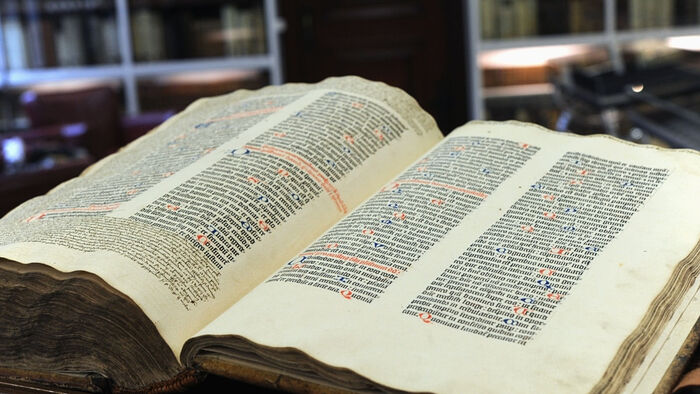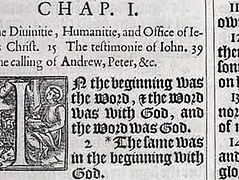Once the poet Alexander Pushkin shrewdly remarked: “I think we will never give people anything better than the Bible… Its taste becomes clear when you start reading the Scriptures, because in it you find all human life...” All human life… However, there have always been those who constantly seek to “perfect” the Word inspired by God Himself—to rewrite, supplement it, or give it their own interpretation, while pursuing, at first glance, “the noblest goals”.
To provide commentaries
The Christian thinker Erasmus of Rotterdam (1466–1536), who tried to expose the faults within the Catholic Church and called the Gospel teachings “the philosophy of Christ”, went down in history as the author of the corrected Greek text of the New Testament with extensive commentaries (1517) and as the “father of Christian humanism”. He took most of the New Testament chapters from twelfth-century manuscripts, translated the missing verses from the Latin Vulgate, and in his comments he explained passages that were hard to understand, in which Catholic theologians saw mystical overtones. According to the theologian, everyone who has a pure heart and a lucid mind can become an interpreter of God’s Word, although the theologian recognized that the Holy Fathers were the best teachers: “Of the interpreters of the Holy Scriptures, first of all choose those who deviate the furthest from the letter. After Paul, these are above all Origen, Ambrose, Jerome and Augustine. After all, I see that modern theologians are very willing to cling to the letter and put more effort into all sorts of tricky subtleties than in unraveling the mysteries—as if Paul did not say that our law is spiritual.” For criticizing the Church, the writings of the forerunner of the European Enlightenment were included by decision of the Council of Trent in the Index of Forbidden Books.
To engrave… for people
In 1692–1696 the Belarusian carver and engraver Vasily Koren, imitating the Western Catholic and Protestant Paupers’ Bibles (forty-page image-tables with stories from Sacred History), created the first engraved illustrated Bible in Russia with captions on subjects from the Book of Genesis and the Apocalypse. This text-free creation was intended for illiterate people. Due to the non-canonical approach to the images, in which appeared a young, beardless Lord, almost all of 1000 printed copies were destroyed by order of the Church. The surviving copy of the book, printed on Dutch paper, can be found in the National Library of Russia in St. Petersburg.
For amusement
1882. France. The writer and journalist Leo Taxil (1854–1907) began as an opponent of the Catholic Church, then suddenly repented and began to expose Freemasonry, thus earning the approval of Pope Leo XIII. Over time, Taxil published The “Amusing Bible” and “The Amusing Gospel”. The goal of these books was to show that the Holy Scriptures had nothing to do with the sacred, that the Bible was full of distortions, contradictions and errors. Parodying Biblical stories, he argued that the Bible had borrowed from various myths, legends, etc. Thus, for example, talking about Noah’s Ark, Taxil was perplexed: “What kind of ark was it? If we add up all the periods of time indicated in this and the following chapters, we will find that Noah, his family and all the animals he saved stayed in the ark for 393 days. Theologians do not explain how eight people could feed and water this whole zoo for over a year and keep the pens clean. They would also have to take care of the animals’ young! How much meat was required! What an extraordinary amount of food! What an extraordinary job for Noah, his wife, their sons and daughters-in-law to clean the ark of animal dung!” And such examples, full of irony and satire, abound in his text. In 1897, speaking in Paris, he boldly stated that he had been fooling the Catholic Church for twelve years. For this the Pope anathematized Taxil, calling the author “a prodigal son who fell away from the Church.”
Without the Resurrection of Christ
In 1881 Leo Tolstoy (1828–1910) published his “Gospel in Brief and a Preface to It”, and in 1884, his treatise, “My Religion. What I Believe.” He set himself the task of presenting his religious views and choosing from the Gospel the words that Christ said, and what was supposedly attributed to Him by myth–makers: “These thoughts and feelings are not mine, but common to all people seeking God.” The writer, while approving of the commandments of Christ, which “exclude all evil from people’s lives,” denied all the miracles of Jesus, arguing that He had an ordinary human nature, condemning the “oddities of the Church dogmas”, the acceptance and approval of persecution, the teaching on the sacraments, etc. How does the “Gospel according to Tolstoy” end? At its end Jesus dies on the Cross. The writer did not believe in the afterlife and the personal resurrection of Jesus Christ or man, attributing this to man’s limited understanding of the Creator.
Exclusively for ladies
An example of an act against traditional views was the publication of the popular bestseller, “The Woman’s Bible”, in 1895. Its author was a zealous activist and a leader of the women’s rights movement Elizabeth Cady Stanton (1815–1902), who believed that women should not obey men. A committee of twenty-six feminist activist interpreters led by Elizabeth decided to “correct” the Biblical interpretations that were allegedly directed against women. Subsequently, Stanton noted that the clergy had denounced her book as “the work of satan.”
With God… and the Fuhrer
In 1940, Adolf Hitler published over 100,000 copies of his version of the Holy Scriptures. Hans Yogbas, an expert on the religious history of the Third Reich, said in an interview, “In 1939, Hitler gathered a group of theologians who were supposed to rewrite the New Testament and prove that Jesus was not a Jew. An Institute was even set up to investigate and eliminate Jewish influence in the German Church. In 1940, this institute published the book, “The Germans with God,” a retelling of the New Testament according to Hitler’s version. It was assumed that this work would become a manual for the Germans on a par with Mein Kampf.” The authors of this book claimed that the name of God was “the Savior of the Suffering”, that the Jews, through the Apostle Paul, distorted the teaching of Christ, and that Jesus was an Aryan, not a Jew. Of course, the commandments, “Thou shalt not kill” and “Thou shalt not steal” were missing in Hitler’s version, and the very first commandment read: “Thou shalt respect thy Fuhrer and God.” Nothing was known about this book for a long time because the faithful had destroyed all the copies.
Without God
Aiming to introduce children to the Bible, under the strict supervision of the Soviet militant censorship, the well-known Soviet children’s writer Korney Chukovsky (1882–1969) in his book, The Tower of Babel and Other Ancient Legends (1968), replaced the word “God” with “the magician Yahweh”, called the Bible stories “legends”, and did not mention Jews, Jerusalem or angels at all. The writer confessed, “We tried to make the Bible narrative, which is sometimes very complex and involved, understandable to children and at the same time, to the best of our abilities and possibilities, to preserve the simple and unsophisticated style of the sublime original.” Nevertheless, the book was banned and the copies were destroyed.
Despite the above-described attempts to rewrite and reinterpret the Bible, most of which naturally failed, the Bible has been leading the popularity ratings for over 2,000 years; and, mind you, it was burned, persecuted, defamed, and even stolen more often than other books. If we compare it with monuments of ancient literature, then more handwritten copies of the Holy Scriptures have come down to our times than any other book. From 1931 on the sale and import of the Book of Books were banned in the atheist Soviet State, and its distribution was punished by repression and exile. By the way, people are still punished for keeping Bibles, for example, in North Korea, where according to a report on persecution of the faith, a case of public execution by someone being tied to a tree and being shot is cited. Meanwhile, without any promotion or advertising slogans, the number of printed copies of this most cited book exceeds 6 billion. The cost of a manuscript of the Bible in the year 1300 was equal to the price of a castle, and in the Soviet era—to a monthly salary. The Bible has been translated into more than 2,500 languages: Go ye therefore, and teach all nations, baptizing them in the name of the Father, and of the Son, and of the Holy Ghost: teaching them to observe all things whatsoever I have commanded you: and, lo, I am with you always, even unto the end of the world (Mt. 28:19-20). The ability of the Holy Scriptures to withstand all sorts of distortions, attacks and criticism throughout all the ages is unique. The writer Nikolai Gogol rightly said, “You can’t invent anything higher than what is already in the Gospel. How many times has humanity turned its back on it, and how many times it has been converted again.” Truly, all earnest seekers of the Truth have always found, and can only find it, in the Word of God.





